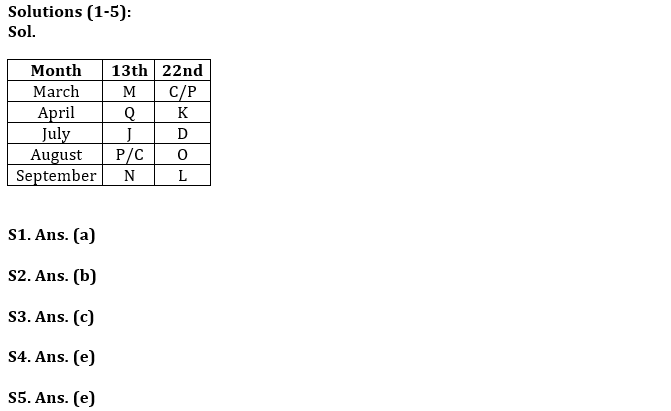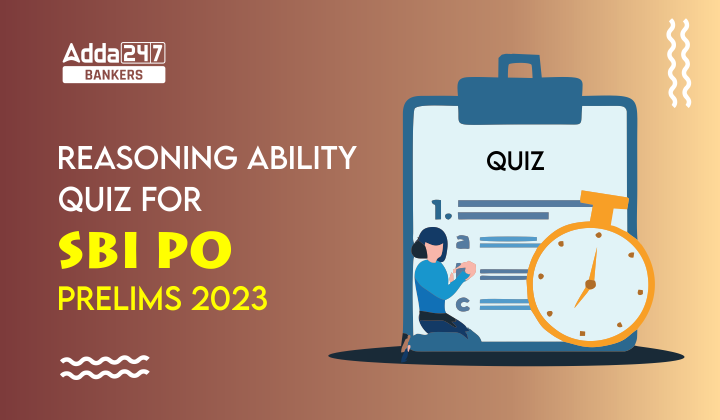Direction (1-5): Study the following information carefully to answer the given questions:
Ten persons are going for vacations on two different dates i.e., 13th and 22nd of five months viz. March, April, July, August and September.
Four persons goes between J and L who goes after J. Q goes on vacation on one of the months before J. Both J and Q goes on the same date. Two persons goes between D and Q. N goes on vacation in one of the months which has 30 days but not on 22nd. K goes immediately after Q. Four persons goes between C and P. P goes on vacation before O and after M.
Q1. Who among the following goes on 13th April?
(a) Q
(b) J
(c) N
(d) D
(e) None of these
Q2. Who among the following goes immediately before D?
(a) N
(b) J
(c) K
(d) Q
(e) None of these
Q3. Who among the following goes on 22nd August?
(a) M
(b) C
(c) O
(d) P
(e) None of these
Q4. C goes on vacation on which among the following date?
(a) 13th March
(b) 22nd March
(c) 13th August
(d) 22nd August
(e) Cannot be determined
Q5. How many persons goes before P?
(a) One
(b) Three
(c) Five
(d) Six
(e) Either One or Six
Directions (6-10): In these questions, relationship between different elements is shown in the statements. These statements are followed by two conclusions:
Q6. Statements: A≥B, C>D, C≥B, K=A<E
Conclusion:
I. C>A
II. E>B
(a) If only conclusion I follows.
(b) If only conclusion II follows.
(c) If either conclusion I or II follows.
(d) If neither conclusion I nor II follows.
(e) If both conclusion I and II follow.
Q7. Statements: A=D, B<L, C≥A, D≤B
Conclusion:
I. D≤C
II. L>D
(a) If only conclusion I follows.
(b) If only conclusion II follows.
(c) If either conclusion I or II follows.
(d) If neither conclusion I nor II follows.
(e) If both conclusion I and II follow.
Q8. Statements: G≥Q, S<K, Q≥S, K<M>I
Conclusion:
I. Q>I
II. M≥S
(a) If only conclusion I follows.
(b) If only conclusion II follows.
(c) If either conclusion I or II follows.
(d) If neither conclusion I nor II follows.
(e) If both conclusion I and II follow.
Q9. Statements: J>N, M>Q, N=P, R≥P, M=R
Conclusion:
I. J≥Q
II. Q>J
(a) If only conclusion I follows.
(b) If only conclusion II follows.
(c) If either conclusion I or II follows.
(d) If neither conclusion I nor II follows.
(e) If both conclusion I and II follow.
Q10. Statements: P=N, R≤Q, M<J, R≤J, Q>N
Conclusion:
I. N≥R
II. N<R
(a) If only conclusion I follows.
(b) If only conclusion II follows.
(c) If either conclusion I or II follows.
(d) If neither conclusion I nor II follows.
(e) If both conclusion I and II follow.
Solutions

S6. Ans. (b)
Sol. I. C>A (False) II. E>B (True)
S7. Ans. (e)
Sol. I. D≤C (True) II. L>D (True)
S8. Ans. (d)
Sol. I. Q>I (False) II. M≥S (False)
S9. Ans. (c)
Sol. I. J≥Q (False) II. Q>J (False)
S10. Ans. (c)
Sol. I. N≥R (False) II. N<R (False)





 GA Capsule for SBI Clerk Mains 2025, Dow...
GA Capsule for SBI Clerk Mains 2025, Dow...
 The Hindu Review October 2022: Download ...
The Hindu Review October 2022: Download ...
 ECGC PO Scorecard 2025 Out, Check Marks
ECGC PO Scorecard 2025 Out, Check Marks




